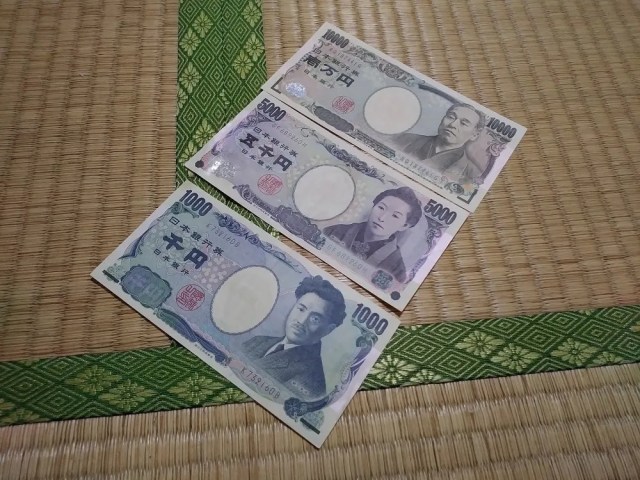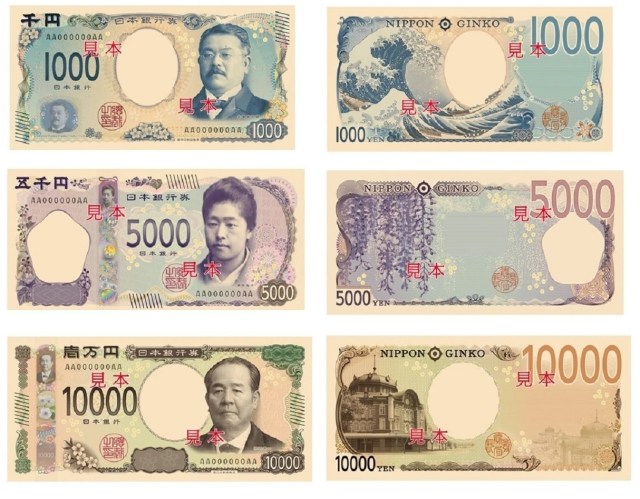
New bills go into circulation this summer.
There’s a big release date coming up in Japan on July 3. It’s not a new video game, anime series, or Japanese Frappuccino, though. It’s the day Japan’s new yen bills go into circulation.
The first redesign of Japan’s paper currency in 20 years is something the government announced back in 2019, and in fact the yen bills currently in use in Japan haven’t been printed since 2022. The new 1,000, 5,000, and 10,000-yen bills not only change up the dignitaries who appear on their front sides, but also have new artwork on their backs, including a reproduction of Japan’s most famous painting, The Great Wave off Kanagawa.
▼ Preview images of the new bills, with “SAMPLE” (見本) markings
Less than two months before the new bills go into circulation, though, the Bank of Japan feels the time is right for a reminder about how currency updates work, and also a warning to beware of scam artists looking to take advantage of the situation, with the following statement made through the organization’s official Twitter account.
“Current-design bills can still be used even after the new bills have been issued, so there is no need to exchange your current bills for the new versions. Please be cautious of false claims that ‘Your current bills will become unusable’ and related fraud attempts.”
▼ The message was accompanied by a photo of the current bills.
The worry is that scam artists will try to convince people that valid current-design cash is just worthless paper after the new bills go into circulation, and offer to exchange them for the new bills while charging a hefty handling or transaction fee in the process.
To money-savvy individuals, that might sound like something you’d have to be pretty gullible to fall for. However, with it having been 20 years since the last yen redesign, and another 20 since the one before that, there are a lot of people for whom this will be the first redesign since they’ve become adults who handle their own money, and their lack of experience might make them vulnerable, especially in a country where many transactions involve putting cash in a vending machine and are reliant on an internal, computerized process (the new bills actually do pose an issue for vending machines, but only because they’ll need updates in order to accept the new versions). Fraudsters might also target senior citizens with reduced cognitive functions, and it’s possible scammers could also go after foreign tourists coming to Japan during the country’s unprecedented inbound travel boom by trying to convince them that the money they either brought with them or got at the currency exchange after arriving is no good.
So remember, whether you’ve got the new versions or the old ones, yen is yen, and anyone who tells you differently is trying to pull a fast one. Oh, and even though it isn’t pictured in the Bank of Japan’s tweet, the current 2,000-yen bill will remain legal tender too, even though it’s rare enough that the Bank didn’t even bother to redesign it.
Source: Bank of Japan via IT Media
Top image ©SoraNews24
Insert images: Ministry of Finance
● Want to hear about SoraNews24’s latest articles as soon as they’re published? Follow us on Facebook and Twitter!


 Why was the 2,000-yen bill left out of Japan’s yen redesign, and how does it feel about the snub?
Why was the 2,000-yen bill left out of Japan’s yen redesign, and how does it feel about the snub? The Bank of Japan is really jazzed up about the new 10,000 yen bill
The Bank of Japan is really jazzed up about the new 10,000 yen bill Japan’s awesomely adorable cat pseudo-currency is actually usable at one very special place【Pics】
Japan’s awesomely adorable cat pseudo-currency is actually usable at one very special place【Pics】 Japanese ramen restaurants under pressure from new yen banknotes
Japanese ramen restaurants under pressure from new yen banknotes Travel tip: McDonald’s Japan will finally let you pay for your food with a credit card
Travel tip: McDonald’s Japan will finally let you pay for your food with a credit card How to order snacks on a Shinkansen bullet train in Japan
How to order snacks on a Shinkansen bullet train in Japan Demon Slayer: Kimetsu no Yaiba gets new roller coaster attractions and food at Universal Studios Japan
Demon Slayer: Kimetsu no Yaiba gets new roller coaster attractions and food at Universal Studios Japan Nintendo history you can feel – Super NES, N64, and GameCube controllers become capsule toys
Nintendo history you can feel – Super NES, N64, and GameCube controllers become capsule toys New Nintendo Lego kit is a beautiful piece of moving pixel art of Mario and Yoshi【Photos】
New Nintendo Lego kit is a beautiful piece of moving pixel art of Mario and Yoshi【Photos】 Japan’s new difficult-to-drink-from beer glass protects your liver, but it’s a brutal experience
Japan’s new difficult-to-drink-from beer glass protects your liver, but it’s a brutal experience A visit to the best UFO catcher arcade in the universe!
A visit to the best UFO catcher arcade in the universe! To combat declining birth rate, Japan to begin offering “Breeding Visas” to foreigners
To combat declining birth rate, Japan to begin offering “Breeding Visas” to foreigners Tokyo Station’s perfect breakfast spot might just be this izakaya Japanese-style pub
Tokyo Station’s perfect breakfast spot might just be this izakaya Japanese-style pub Sex doll sharing service shut down by Chinese authorities
Sex doll sharing service shut down by Chinese authorities High-fashion Totoro cuddle purse is like an elegant stroll in the forest【Photos】
High-fashion Totoro cuddle purse is like an elegant stroll in the forest【Photos】 Hello, cosmetics! Clinique teams up with Hello Kitty this summer for first-time collaboration
Hello, cosmetics! Clinique teams up with Hello Kitty this summer for first-time collaboration “The most Delicious Cup Noodle in history” – Japan’s French Cup Noodle wins our heart【Taste test】
“The most Delicious Cup Noodle in history” – Japan’s French Cup Noodle wins our heart【Taste test】 Starbucks releases a cute Frappuccino and Unicorn Cake…but not in Japan
Starbucks releases a cute Frappuccino and Unicorn Cake…but not in Japan Kyoto Tower mascot termination reveals dark side behind cute Japanese characters
Kyoto Tower mascot termination reveals dark side behind cute Japanese characters McDonald’s Japan’s Soft Twist Tower: A phantom ice cream only sold at select branches
McDonald’s Japan’s Soft Twist Tower: A phantom ice cream only sold at select branches Yabai Ramen: What makes this Japanese ramen so dangerous?
Yabai Ramen: What makes this Japanese ramen so dangerous? Finally! Nintendo Japan expands Switch 8-bit controller sales to everybody, Online member or not
Finally! Nintendo Japan expands Switch 8-bit controller sales to everybody, Online member or not Japanese government wants to build luxury resorts in all national parks for foreign tourists
Japanese government wants to build luxury resorts in all national parks for foreign tourists 10 things you should buy at 7-Eleven in Japan
10 things you should buy at 7-Eleven in Japan Studio Ghibli releases anime heroine cosplay dresses that are super comfy to wear
Studio Ghibli releases anime heroine cosplay dresses that are super comfy to wear Woman charged for driving suitcase without a license in Osaka
Woman charged for driving suitcase without a license in Osaka Studio Ghibli unveils My Neighbour Totoro miniature house model
Studio Ghibli unveils My Neighbour Totoro miniature house model Kyoto experiencing problems with foreign tourists not paying for bus fares, but not on purpose
Kyoto experiencing problems with foreign tourists not paying for bus fares, but not on purpose Fighting mild hunger with a Japanese soda that turns into jelly in the stomach【Taste test】
Fighting mild hunger with a Japanese soda that turns into jelly in the stomach【Taste test】 Studio Ghibli’s Howl’s Moving Castle tapestry unveiled in Japan for first time
Studio Ghibli’s Howl’s Moving Castle tapestry unveiled in Japan for first time McDonald’s new Happy Meals offer up cute and practical Sanrio lifestyle goods
McDonald’s new Happy Meals offer up cute and practical Sanrio lifestyle goods Sales of Japan’s most convenient train ticket/shopping payment cards suspended indefinitely
Sales of Japan’s most convenient train ticket/shopping payment cards suspended indefinitely Sold-out Studio Ghibli desktop humidifiers are back so Totoro can help you through the dry season
Sold-out Studio Ghibli desktop humidifiers are back so Totoro can help you through the dry season Japanese government to make first change to romanization spelling rules since the 1950s
Japanese government to make first change to romanization spelling rules since the 1950s Foreigner’s request for help in Tokyo makes us sad for the state of society
Foreigner’s request for help in Tokyo makes us sad for the state of society Ghibli founders Toshio Suzuki and Hayao Miyazaki contribute to Japanese whisky Totoro label design
Ghibli founders Toshio Suzuki and Hayao Miyazaki contribute to Japanese whisky Totoro label design Doraemon found buried at sea as scene from 1993 anime becomes real life【Photos】
Doraemon found buried at sea as scene from 1993 anime becomes real life【Photos】 Tokyo’s most famous Starbucks is closed
Tokyo’s most famous Starbucks is closed Princesses, fruits, and blacksmiths: Study reveals the 30 most unusual family names in Japan
Princesses, fruits, and blacksmiths: Study reveals the 30 most unusual family names in Japan Japan considering restricting senior citizens’ access to ATMs
Japan considering restricting senior citizens’ access to ATMs Japan issuing beautiful new coins to celebrate Emperor Naruhito’s enthronement
Japan issuing beautiful new coins to celebrate Emperor Naruhito’s enthronement Here’s why Japan won’t do anything about the crazy yen surge
Here’s why Japan won’t do anything about the crazy yen surge Executives arrested from scam dating sites that had 2.7 million users and only one female member
Executives arrested from scam dating sites that had 2.7 million users and only one female member How to spot the new sophisticated counterfeit bills circulating in Japan
How to spot the new sophisticated counterfeit bills circulating in Japan “Foreign travelers are Japan’s guests” – Governor against charging tourists more than locals
“Foreign travelers are Japan’s guests” – Governor against charging tourists more than locals Man in Tokyo tries to pay for sex with toy check
Man in Tokyo tries to pay for sex with toy check In Luffy we trust – Man arrested for selling dollar bills with unlicensed One Piece stickers
In Luffy we trust – Man arrested for selling dollar bills with unlicensed One Piece stickers “Donald Trump” fraudster accused of scamming confused citizens in Japanese phone scam
“Donald Trump” fraudster accused of scamming confused citizens in Japanese phone scam Weak yen should have Japan fast-tracking reopening to foreign tourists, prominent politician says
Weak yen should have Japan fast-tracking reopening to foreign tourists, prominent politician says Tokyo vending machine sells beautiful shugifukuro money envelopes for wedding and other gifts
Tokyo vending machine sells beautiful shugifukuro money envelopes for wedding and other gifts Four foreign men arrested near Tokyo under charges of “international romance fraud”
Four foreign men arrested near Tokyo under charges of “international romance fraud” How a bar in Kabukicho scammed one diner out of their money, and how it can happen to you too
How a bar in Kabukicho scammed one diner out of their money, and how it can happen to you too Nagoya man goes to bars, shows everyone 20 million yen; you’ll totally believe what happens next
Nagoya man goes to bars, shows everyone 20 million yen; you’ll totally believe what happens next Osaka woman gives foreigner Uber Eats worker fake money, thought he wouldn’t know difference
Osaka woman gives foreigner Uber Eats worker fake money, thought he wouldn’t know difference Man in Japan orders female store clerk to prostrate herself over misunderstanding with his change
Man in Japan orders female store clerk to prostrate herself over misunderstanding with his change
Leave a Reply